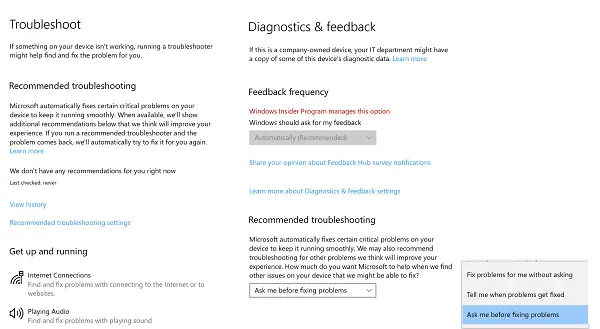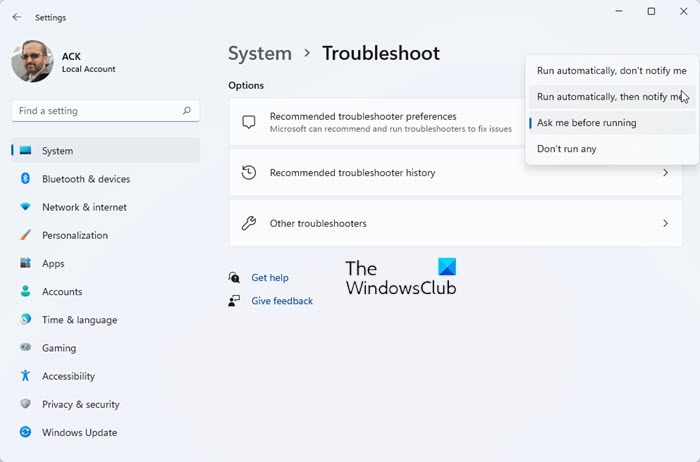What started with Microsoft Fix-It, has now grown into an automated solution. It’s been a long since we have troubleshooters as part of Windows. Starting with Windows 10 v1903, the Windows team took it to the next level. It’s called Recommended troubleshooting which can automatically fix problems that occur in your Windows 11/10 computer and notify you about them. In this guide, we will share how you can make Windows 11/10 run Troubleshooters automatically when required.
Make Windows 11 run Troubleshooters automatically
Not only can the program perform troubleshooting, but it can also apply the fix. Many consumers do not want to take a headache of looking at the notifications and want it to work while some who are tech-oriented would want to know what happened.
To apply this Recommended troubleshooting setting in Windows 10:

- Open Settings > Update and Security > Troubleshooting
- Click on the link which says “Recommended troubleshooting settings.”
- It will take you to Diagnostics and Feedback. Here you can choose between three options
- Ask me before fixing the problems.
- Tell me when problems get fixed.
- Fix problems for me without asking.
- Select the last one to automate troubleshooting.
It will make sure whatever Windows can fix will be fixed when the error occurs. If you wish to disable automated troubleshooting, select the first option.
To apply this Recommended troubleshooting setting in Windows 11:

- Open Settings > System > Troubleshoot
- Click on the link which says “Recommended troubleshooting preferences.”
- Here you can choose between four options
- Run automatically, don’t notify me
- Run automatically, then notify me
- Ask me running
- Don’t run any.
- Select the one you want to automate troubleshooting.
The following Troubleshooters are available for recommended automatic troubleshooting:
- Internet connections
- Playing Audio
- Printer
- Windows Update
- Blue Screen
- Bluetooth
- DirectAccess
- Incoming Connections
- Keyboard
- Network Adapter
- Power
- Program Compatibility Troubleshooter
- Recording Audio
- Search and Indexing
- Shared Folders
- Speech
- Video Playback
- Windows Store Apps.
Related: Turn off Recommended troubleshooting in Windows 11
Troubleshooting History
If you want to see what Windows has fixed, go back to Troubleshooting and click on View History. It will only list those fixes which ran automatically and not by you. If you run a recommended troubleshooter and the problem reoccurs, Windows will try to fix it for you again.
Apart from fixing problems, Microsoft will also show additional recommendations to improve the user experience. Give it time if you don’t see anything, and you may get some.
I am very excited about this feature, but at the same time, one will have to give it time to mature. Microsoft collects diagnostic data from your computer, and based on other computers and their experience, they can interpret the problem and the solution.
Will you let Windows 11/10 run Troubleshooters automatically? Or do you like to keep things under your control?
Leave a Reply